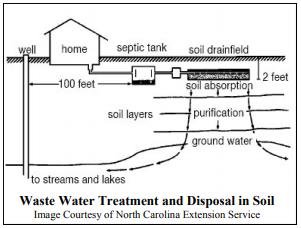Well Owner Responsibilities
View/Download PDF Version
Well Owner Responsibilities
By W. Adam Sigler and Jim Bauder Montana State University Extension Water Quality Program Department of Land Resources and Environmental Sciences
Keeping a "Well File"
Keeping a “Well File” and a “Septic File” with all information related to your water
system is an important part of protecting your water resources. Good records make
it easier to schedule water system maintenance and can help with figuring out potential
causes of changes in water quality.
- Construction: When a well is drilled the drilling company is required to submit a well log to the Montana Bureau of Mines and Geology (MBMG). This log includes information about well depth, casing diameter, depth to water, and materials drilled through. These well logs are available online at the MBMG Ground Water Information Center website referenced on the back of this page.
- Maintenance: Whenever work is done on your well or septic system, keep a record of who preformed the work, when it was done, what exactly was done, and the cost.
- Water Quality: Copies of all water quality test results should be kept to track possible changes through time.
- Water Treatment Maintenance Schedule: If you have a water treatment system it requires some type of maintenance; keeping records of service can help you remember when the next service is due.
Protecting the Well Head
Well head protection is an essential part of protecting the quality of water from a well. Soil is an excellent filter which removes many contaminants from water as it moves downward. This is why groundwater is usually of very good quality. However, when a well is drilled, it cuts down through all the filtering layers and provides a quick path for contaminants to travel to groundwater if the well is not properly constructed and maintained.
Easy steps to protect the well head:
- Install a sanitary well cap with a rubber gasket and a screen over the vent to keep insects and rodents out of the well.
- Insure that the ground surface is shaped so water flows away from the top of the well and water does not pond near the well.
- Install backflow prevention devices on outdoor faucets to prevent water from siphoning up through a hose and into your well. The risk from backflow is highest when the end of the hose is underwater especially when mixing chemicals.
These steps are a beginning; for more information about protecting your well head see the MSUEWQ website referenced on the back of this page.
Water Quality Testing
Regular testing of well water quality is essential to monitor the integrity of your
water supply. Nitrates and bacteria should be tested for each year. It is also a good
idea to test for a more complete set of parameters initially and again each 5 years.
More information on water testing is available on the MSUEWQ website referenced below.
Locating Hazardous Material Storage Areas away from Wells
Imagine your well with rings around it at 50, 100, and 250 feet like a bull’s-eye. These rings are zones around your well where different potential contaminants should not be stored.
- < 50 ft - any sewer line should be outside this zone
- < 100 ft - septic tanks, leach fields, livestock yards, fuel tanks, pesticide and fertilizer storage should be outside this zone
- < 250 ft - manure and storage piles should be outside this zone
These separation distances are minimums. Additionally, it is important to think about what is uphill from your well head and might flow toward your well when it rains.
 Maintaining Septic Systems to Protect Groundwater
Maintaining Septic Systems to Protect Groundwater
Septic systems are designed to break down and dispose of the waste from your home so that it does not impact surface water or groundwater. Failure to have your septic system pumped on the recommended schedule could result in a shorter life of your leach field and contamination of ground water and/or surface water. For more information on septic system function and maintenance see the MSUEWQ website referenced below.
Locating and Decommissioning Wells No Longer in Use
Abandoned wells that have not been properly decommissioned pose a large threat to water quality. Wells are drilled down through the natural filtering layers of the soil and can provide a direct path for contaminants to get to groundwater. Abandoned wells can channel bacteria, nitrates, and other surface water contaminants directly into groundwater. For more information about locating and decommissioning old wells see the MSUEWQ website referenced below.
Water Conservation
Ground water is held in subsurface reservoirs called aquifers. Aquifers are areas where the cracks and spaces between rocks and soil are filled with water. We can think of aquifers in much the same way as reservoirs on the surface. If we take water out faster than we put it in, the water level goes down. Water flowing into aquifers is called recharge and can come from snow, rain, streams, and irrigation water. Water can flow out of an aquifer into wells or into surface water through springs or seeps. If outflow is continually greater than inflow, the drop in ground water can cause wells to go dry as well as reduce flow to springs and seeps. As more wells are drilled to take water out of an aquifer, it becomes more important to be conscious about the amount of water each well uses. For more information on water conservation see the MSUEWQ website referenced below.
Additional Resources:
Montana State University Extension Water Quality (MSUEWQ) website:
http://waterquality.montana.edu/docs/homeowners.shtml
Montana Bureau of Mines and Geology: Ground Water Information Center
